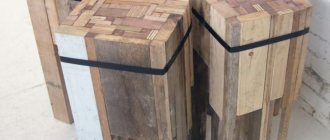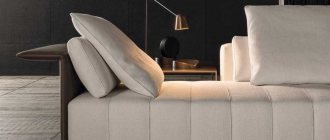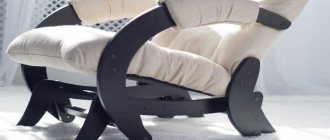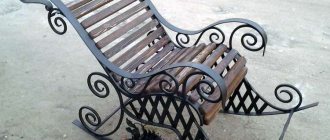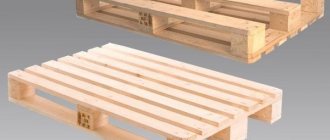Making such a piece of furniture is easy and simple with your own hands. To do this, just choose the most suitable type of design, stock up on consumables and free time.
Peculiarities
The features of the hammock chair include:
safety and environmental friendliness (due to the use of natural and non-toxic materials);- original design;
- simplicity and ease of use;
- Possibility of use at any time of the year;
- ease of care;
- long service life.
A hammock chair is a soft version of a hanging structure . On soft pillows that sway from side to side, it is pleasant to spend summer evenings in the fresh air.
Advantages
The advantages of a hammock chair include::
- Wide selection of models. Such products differ in shapes, designs, colors, and materials of manufacture. Some chairs are something like a cocoon, others are a product with a soft fabric seat.
- Possibility of self-production. To do this, you will need to use minimal sewing skills and prepare supplies.
- A hammock chair can be framed or frameless. Both models do not have sharp corners or parts, which makes them popular among small users.
- The textile can be easily detached from the product and washed in an automatic machine.
Device
A hammock chair, as a rule, has a fairly simple design . It consists of:
Fabric seat. For these purposes, a tight cut is most often used.- Crossbars, which serve as a strapping element and distribute the load. The seat is tied to the crossbar.
- Sling. To do this, use a strong rope or braided cord.
- Suspension. For these purposes, chains for ceiling mounting or rings with a spring are used.
Selecting a location
To successfully attach a hammock with your own hands, you need to accurately select the location. If the intended installation is carried out in natural conditions, then two trees with the required trunk thickness are searched. The distance between them is set to determine the hanging height.
The following requirements apply to a specific installation location:
- reliable protection from wind and sun;
- the area under the product must be level (after rain, existing holes will fill with water, turn into puddles, and spoil comfortable conditions for relaxation);
- distance from noise sources (garage, pumping station, transformer, highway, etc.);
- proximity to beautiful and cozy corners of the garden or plot: near the pool, gazebo, on the terrace, in the patio area.
The surrounding attractive landscape is considered a good location. This will allow you to fully enjoy your vacation, the beauty of nature or your own plot.
Materials
A hammock chair can be made from different materials:
- rattan or wicker;
- with a base made of plastic or acrylic;
- made of thick textile without frame;
- non-standard models in the form of a drop.
Attention : when using the product outdoors, durable and wear-resistant materials are selected. They must cope with negative environmental factors and be resistant to rain, direct sunlight and ultraviolet rays and temperature changes.
As for the materials used to make the hammock chair, the type of construction and model are taken into account . The most common are:
Macrame. In this way, the products are decorated on a hoop, which is braided with a silk cord that is soft to the touch. Using this method, original products with fringe and various decorative elements are created.- Tarpaulin.
It is a fairly durable material and is perfect for outdoor use. The tarpaulin can withstand heavy loads up to 300 kg. It is not afraid of sudden changes in temperature, increased moisture, or direct sunlight. Its only drawback is the small selection of color palettes . This model will look harmonious on the veranda, in the garden or gazebo. - Textile. For these purposes, dense fabric is selected that can withstand weight up to 150 kg. Also, the selected material should not stretch or deform during operation. To increase the strength of the material, it is recommended to fold it in two layers. You should avoid light and easily soiled colors . Especially when using the product outdoors.
Step-by-step DIY process
So, let's start the workflow:
- We take a hoop, in our case it is a product with a diameter of 95 cm, and fabric (2 pieces, 120 cm in diameter).
- We place the hoop clearly in the middle of the fabric and apply a dotted line around the circumference with a marker and a centimeter, leaving a margin of 25 cm. You shouldn't make a model that is too deep. It will be difficult to get out of it.
- Trim off excess fabric with scissors.
- We do the same with the second piece of fabric.
- We insert a zipper into one of the segments, making a neat cut in the middle of the material with scissors.
- We fold two pieces of fabric face to face and sew them together using a sewing machine. The zipper should be open during sewing.
- We turn the sewn cover inside out and make 4 holes along the edges of the hula hoop according to the diagram. The rope will be threaded through these holes in the future.
- We process the edges of the holes on a machine using trouser braid (this will prevent the material from fraying and make the product decorative).
- We cover the hoop with filler (sintepon). Instead of padding polyester, you can use foam rubber or ordinary pieces of fabric. You can wrap the hoop with filler in any order. The main thing is to grab it tightly with a thread so that it does not unfold. This procedure is necessary to ensure that you can relax comfortably in the hammock.
- We put the cover on the manufactured frame.
Important! To sheath the hoop, you must use strong nylon or synthetic threads. It is better to sew the product several times and with small stitches.
The process of making a hammock is described in more detail in this video:
Mounting options for home
The type of fastening of a self-made product can be:
Ceiling. To do this, use a hook attached to the ceiling. A chain is attached to it, which will hold the product. With such a model it will be pleasant and comfortable to swing from side to side.- Axial.
This option is also attached to the ceiling. But additional slings are installed on the sides of the seat, attached to the walls or ceiling. It will not be possible to swing on such a product like on a swing; the seat will only rotate around its own axis . - Shtangov. For this purpose, a special curved stand with a ring stop at the bottom is used. A suspension consisting of a ring and a spring with a chain is mounted at the top of the rod. This option is durable, reliable and stable.
- In the form of a platform with a double suspension. It is a strong and stable base equipped with sidewalls. This type of fastening is suitable for installing a spacious double chair.
- With a crossbar, at the ends of which rings with cords and a suspension are put on.
Rafter-webbing suspension system
The finished hammock is equipped with slings (straps). They are a mandatory structural part of the product. Slings are a continuation of the product. The slings include connecting elements and grips:
- rope branches;
- links;
- hooks;
- rings;
- staples;
- carbines.
Slings (straps) are made of thick rope or belt. To create one of the common variants of the rafter-webbing system, a belt 8 m long is taken. Then it is divided into 4 segments. They can be equal in length or different. If the length is not kept the same for all segments, then equal sizes are set for paired straps.
A knot is tied on the carabiner.
An adjustment bar can be used. Then the installed product will receive an aesthetic appearance and become more convenient to use.
The belt is threaded in one direction and pulled out the other.
The belt is passed through the hole in the carabiner. Then it is inserted into the adjustment bar.
The end of the belt is brought out.
The end of the belt (tail) must be fixed.
This place is stitched with dense nylon thread. Sewn with small, dense stitches. You will have to sew 3 layers. Alternatively, you can install one metal rivet.
4 straps are constructed and attached to the rim (harness) on four sides with carabiners.
The slings are tied in pairs (on both sides) to a bar horizontally located between the branches of the trees. The distance between the slings should be 40–60 cm. The length of the straps can be adjusted, giving different configurations to this piece of furniture.
To customize the seat, the front straps are made longer and the rear straps shorter.
Rafter-webbing systems allow hanging loungers to be used as chairs and swings. This type of fastening is quite reliable and less labor-intensive. There is no need to carry out complex calculations or consult drawings in the smallest detail.
Scheme and drawing
Before you start making your own hammock chair, you will need to make a drawing of it. To do this you can:
- Use options found on the Internet. Among their variety, each person will choose the option that suits them, which can be modified according to their own preferences.
- Draw a diagram of the future product with a pencil on paper. For this option, you must be able to independently determine the dimensions and calculate every detail .
Specifications
Essentially, a hammock tent is a piece of durable material equipped with rope connections with which it is attached to trees. The product consists of:
- hammock (single, double or king-size);
- mosquito net covering the space around;
- shelter - protection from bad weather.
Hammock tents, which come in a variety of sizes, are designed for those who like to hike without burdening themselves with extra cargo. Many people use them for family outings and road trips.
Sitting comfortably in the “hanging canopy bed” you can wait out the rain or hide from the scorching sun. They do not provide home comfort and have their drawbacks, but at the moment there is no more popular product for outdoor enthusiasts.
Hammocks with crossbars are good for relaxing in the country or at a campsite. For travel there are models “without extra poles”. The main material is durable fabric with water-repellent properties. These can be classic linen, cotton, or lightweight synthetic materials with increased strength.
Hanging beds also differ in design features. Some (ascetic type) are presented in the form of a light, even canvas, others are endowed with many additional details: pockets, insulation, and other improvements.
Advantages and disadvantages
The same thing can be perceived in different ways: someone loves green apples and praises them, while others like overripe fruits and will never look in the direction of “green”.
So it’s reckless to say clearly which qualities of a hammock-tent are advantages, and which ones, on the contrary, are reckless. Anyway, everyone will choose the characteristics according to their preferences
We only focus on the best and not the best qualities of products.
Pros:
- weight up to 1.6 kg (a win-win option for minimalist tourists, fragile women and children);
- compactness (takes up little space when folded);
- no need to bother with preparing, leveling, or insulating the surface (two stable supports for hanging are enough);
- quickly installed;
- It is very comfortable to sleep in a sleeping bag with an awning;
- not a single insect or reptile will penetrate into a hammock with a mosquito net;
- in case of an unforeseen overnight stay in the forest, two trees are enough to hang a hammock (there is no need to clear the sleeping area from cones, sticks or stones, as is the case with a regular tent);
- You can make a hammock from a regular awning by stretching it between trees or other supports.
Disadvantages:
- a camping hammock is designed for one or two people;
- in case of bad weather, you will have to forget about comfortable accommodation;
- In winter, a backpacking hammock is colder than a ground-based winter tent.
If you have a hammock tent with you, you can easily position yourself right in a dense, impenetrable forest and at the same time remain unnoticed. Using a hammock with a mosquito net will not only protect you from annoying mosquitoes, but also provide you with a complete overview of the area. What is so lacking in ordinary tourist tents.
Let's start decorating
The winding for a pastorelli hoop or a product from any other manufacturer is created in this way:
- preparatory stage (thinking through the style, drawing the boundaries of the winding if necessary);
- fix the beginning of the tape on the hoop using transparent stationery tape;
- start wrapping the product (it is best to do this at an angle of 45 degrees);
- after the winding reaches the desired point, you should re-secure the tape with tape;
- when the tape is secured, you will need to go over it with a layer of transparent tape;
- repeat this operation with ribbons of other colors;
- If necessary, you can go around the hoop with additional edging after you have completely finished the wrapping.
Try to wrap the regular strips as tightly as possible. Also, the stripes should not overlap one another too much. And in order for the layer of adhesive tape to easily lay on the wrapped tape, slightly move the corner of its wrapping from the beginning of the tape on the hoop.



